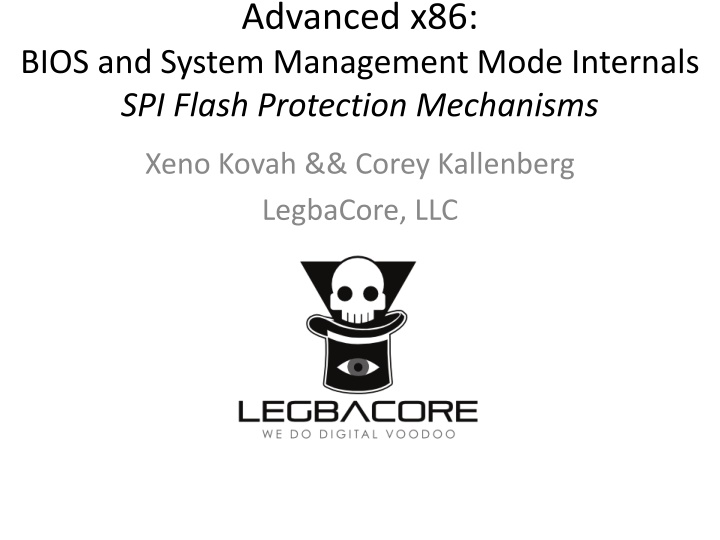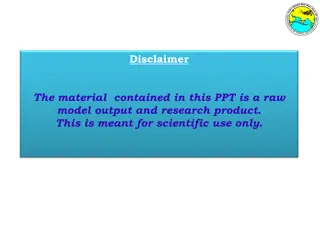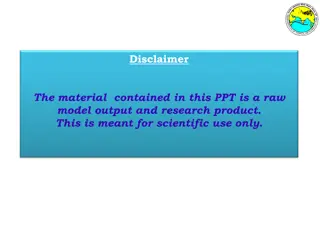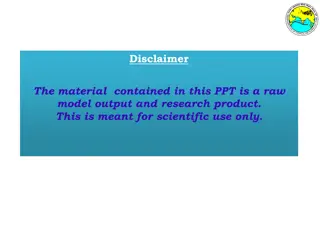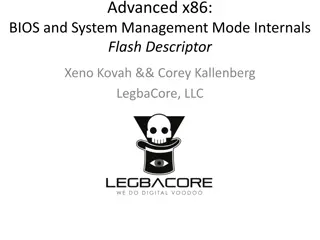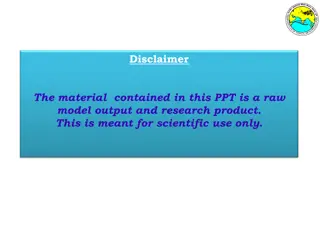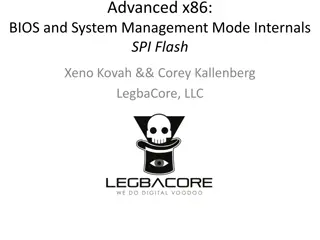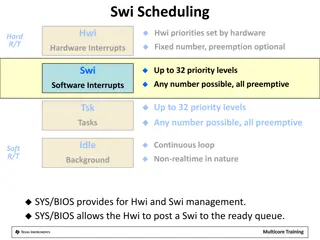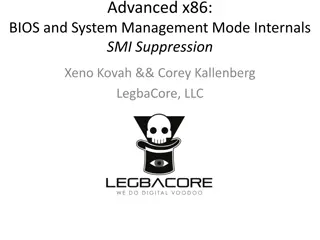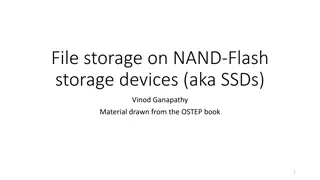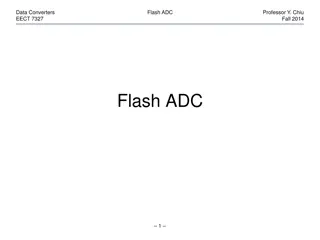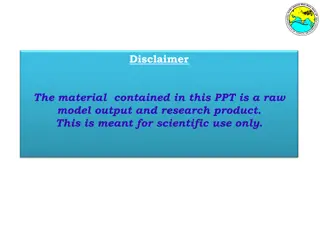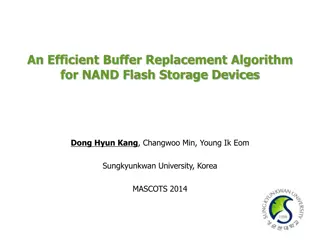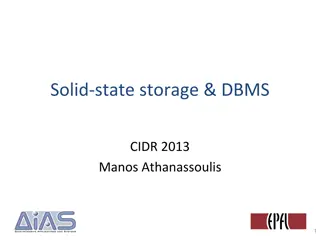Securing BIOS: Flash Protection Mechanisms and Best Practices
Explore advanced x86 BIOS security mechanisms like Global Flash Protection, Global BIOS Write Protection, and SMM-derived Write Protection to prevent unauthorized writing to the BIOS. Discover how BIOS vendors can enhance security configurations to thwart attackers effectively.
Download Presentation

Please find below an Image/Link to download the presentation.
The content on the website is provided AS IS for your information and personal use only. It may not be sold, licensed, or shared on other websites without obtaining consent from the author.If you encounter any issues during the download, it is possible that the publisher has removed the file from their server.
You are allowed to download the files provided on this website for personal or commercial use, subject to the condition that they are used lawfully. All files are the property of their respective owners.
The content on the website is provided AS IS for your information and personal use only. It may not be sold, licensed, or shared on other websites without obtaining consent from the author.
E N D
Presentation Transcript
Advanced x86: BIOS and System Management Mode Internals SPI Flash Protection Mechanisms Xeno Kovah && Corey Kallenberg LegbaCore, LLC
All materials are licensed under a Creative Commons Share Alike license. http://creativecommons.org/licenses/by-sa/3.0/ Attribution condition: You must indicate that derivative work "Is derived from John Butterworth & Xeno Kovah s Advanced Intel x86: BIOS and SMM class posted at http://opensecuritytraining.info/IntroBIOS.html 2
How to stop someone from writing to your BIOS AKA How to stop an attacker from writing to your BIOS AKA What the BIOS vendors are typically configuring wrong when they re supposed to be stopping attackers from writing to your BIOS 3
Flash Protection With no Flash Descriptor present, the only mechanisms to lock the flash are: BIOS Range Write Protection Global Flash Write Protection The reference to FWH Sector Protection yields no results in any datasheets. I am assuming it is related to the R/W control shown in the sample FWH register map at the beginning of the BIOS Flash section 4
Flash Protection Mechanism #1 Covering this first because I believe it to be your first line of defense to protect your BIOS flash from writes Applies to the entire flash chip (Global Flash Protection) Provides SMM the ability to determine whether or not a request to unlock the BIOS flash for writing will be permitted This protection is provided by the chipset (not on the flash itself) 5
Global BIOS Write Protection On MCH/ICH systems, bits 7:5 of the BIOS_CNTL are reserved On this system BIOS_CNTL is located in the LPC device (D31:F0, offset DCh) These protections would also apply to the Firmware Hub (FWH) if the BIOS were located there. 6
ICH/PCH Chipset SMM-derived Write Protection: BIOS_CNTL.BIOSWE (bit 0) enables write access to the flash chip Always R/W BIOS_CNTL.BLE (bit 1) provides an opportunity for the OEM to implement an SMI to protect the BIOSWE bit 7
How you should think of BLE RAM CPU SMRAM (SMI Handler) I help! SPI I sort of provide BIOS access control! ICH or PCH Flash Chip
How it works SMM Privileged Application BLE = 1 BIOS_CNTL BIOS_CNTL.BIOSWE = 1 BIOSWE = 0 Privileged app wants to write to the SPI flash, sets BIOS_CNTL.BIOSWE to 1 The only reason privileges are needed is to execute the in/out instructions 9
How it works SMM SMI Privileged Application BLE = 1 BIOS_CNTL BIOSWE = 1 The BIOS_CNTL register has the BIOS Lock (BLE) enabled Asserting BIOSWE while BLE is set generates an SMI# SMI# is initiated by the Chipset (ICH) The processor transitions to System Management Mode 10
How it works No no no, this will never do SMM Privileged Application BLE = 1 BIOS_CNTL BIOSWE = 1 A routine in the SMI handler explicitly checks to see if BIOS_CNTL.BIOSWE is set 11
How it works Much better SMM Privileged Application BLE = 1 BIOS_CNTL BIOSWE = 0 The SMI handler flips this bit back to 0, disabling writes to the serial flash Since updates should be applied only by SMRAM, SMRAM knows that unless it flipped this bit, this bit shouldn t be flipped. 12
How it works Heh heh heh Aw SMM Privileged Application BLE = 1 BIOS_CNTL BIOSWE = 0 From the app s perspective, it appears the BIOSWE bit was never even asserted. Of course this only works if: BLE is asserted/enabled There is a SMI handler explicitly checking/resetting the BIOSWE bit SMIs cannot be somehow suppressed (you already saw 1 way) 13
vulnBIOS example: BIOS_CNTL Testing Look at the BIOS_CNTL register in the LPC device BIOS Lock Enable (BLE) bit 1 is not asserted This means any application privileged enough to either map the PCI Express configuration space or perform port I/O can assert BIOSWE to enable writes to the BIOS flash 14
vulnBIOS example: BIOS_CNTL Testing You don t have to do this, but note that it is possible to set BIOS Lock Enable to 1 and not have an SMI handler routine running that checks and de-asserts BIOS Write Enable bit 0 We've seen this on multiple systems; where BLE was set, but asserting BIOSWE to 1 was not reset to 0 This is why bit 0 must be tested in order to really test write-protection 15
vulnBIOS example: BIOS_CNTL Testing: Set BLE Now we re going to setup BIOS_CNTL so that it protects the flash This will only work on these lab machines with this modified BIOS I inserted a custom SMI handler that resets the BIOSWE bit to 0 if it is asserted We re going to enable this by writing the word 0xb105 to port 0xB2 You should now see the BLE bit asserted in BIOS_CNTL (0x0A) 16
vulnBIOS example: BIOS_CNTL Testing Now try to enable writes to the BIOS by asserting BIOSWE bit 0 Set BIOS_CNTL to 0x0B You will notice that it resets to 0x0A This is the SMI handler working as it should Note the reset of BIOSWE to 0 occurs during SMM Any tangible delay you see in resetting this value is due to the (configurable) Refresh button in RW-E Bit 0 is de-asserted 17
BIOSWE/BLE should be considered deprecated! We can defeat it on systems that are not using SMRRs "The Sicilian" "Defeating Signed BIOS enforcement", Kallenberg et al., EkoParty 2013 We can defeat it on systems that don't set SMI_LOCK "Charizard" "Setup for Failure: Defeating UEFI Secure Boot", Kallenberg et al., Syscan 2014 But Charizard actually found by Sam Cornwell, it just got merged into Corey's talk in its first appearance. Will be spun off later. We can defeat it on systems TXT-enabled that suppress SMIs "Sandman" "SENTER Sandman: Using Intel TXT to attack BIOSes", Kovah et al., Summercon 2014 We have a new fundamental attack against it that will bypass BLE on all systems, once and for all. Speed Racer We ll talk about these at the end, depending on time. 18
BIOS_CNTL: SMM_BWP In PCH chipsets, bit 5 of BIOS_CNTL has been defined: Provides the vendor the ability to ensure that BIOS region may ONLY be written to when all processors are in SMM and BIOSWE is enabled Our lab system does not implement this bit because it is an MCH/ICH system, but check it out on your own As we ve seen, this register is important to lock down the BIOS to mitigate SMI suppression Same here Only 6 out of ~10k systems we ve measured to date use it!!! As of 3/31/2014 19
Another Protection Mechanism BIOS Range Write-Protection is the second major line of defense There are 5 Protected Range registers (0-4) with independent R/W permissions Setting these will prevent reads and/or writes until the system is reset. * Information on FWH Sector Protection is hard to come by. It appears to be a security mechanic on the chip itself, since chips can be described as being divided into sectors. 20
So who protects the protector? This guy that s who! We ll get to that later Example of a Protect Range Register 21
Protected Range (PR) Registers The protections prescribed herein are enforced even upon the SMI handler Enforced on register access, not direct access, however Protected ranges are available to a SPI flash operating in either Non-Descriptor mode or Descriptor mode The ranges don t have to mirror descriptor mode regions Base addresses must be page-aligned Lower 12 bits are 000h Limit addresses end at one under a page aligned boundary Lower 12 bits are FFFh Addresses are Flash Linear Addresses (FLAs) Basically an offset from the base of the flash So offset 0x260000 on the flash is Flash Linear Address 0x260000 22
PR Sample: 03FF02A2h Base 2A2000h Protected Range Base 31 30 29 28 27 26 25 24 23 22 21 20 19 18 17 16 15 14 13 12 11 10 9 8 7 6 5 4 3 2 1 0 W P R P 0 0 0 1 1 1 1 1 1 1 1 1 1 0 0 0 1 0 1 0 1 0 0 0 1 0 FLAbase = 2A2000h 24 23 22 21 20 19 18 17 16 15 14 13 12 11 10 9 8 7 6 5 4 3 2 1 0 0 0 0 1 0 1 0 1 0 0 0 1 0 0 0 0 0 0 0 0 0 0 0 0 0 To set a PR from a Flash Linear Address Limit: PRbase = ((page-aligned FLAbase) & FFF000) >> 12 PRbase |= 2A2 = 0000002A2h To write-protect this range: PR0 | = 80000000h To read-protect this range: PR0 |= 00008000h *We re picking a funny base because the offset at the real BIOS base is normally all 0xFF s so it s harder to illustrate the point. This example will show us a visible boundary whereas the real BIOS base address would not. 23
PR Example: 03FF02A2h Limit 3FFFFFh Protected Range Limit 31 30 29 28 27 26 25 24 23 22 21 20 19 18 17 16 15 14 13 12 11 10 9 8 7 6 5 4 3 2 1 0 W P R P 0 0 0 1 1 1 1 1 1 1 1 1 1 0 0 0 1 0 1 0 1 0 0 0 1 0 FLAlimit = 3FFFFFh 24 23 22 21 20 19 18 17 16 15 14 13 12 11 10 9 8 7 6 5 4 3 2 1 0 0 0 0 1 1 1 1 1 1 1 1 1 1 1 1 1 1 1 1 1 1 1 1 1 1 To set a PR from a Flash Linear Address Limit: PRlimit = (page-aligned FLAlimit) << 16 PRlimit = 3FF000 << 4 = 03FF02A2h To write-protect this: PR | = 80000000h To read-protect this: PR |= 00008000h 24
vulnBIOS Example: Protected Range Registers 260000h (start of BIOS region) BIOS Region 3FFFFFh (BIOS limit) On our lab E6400, the BIOS region occupies the range 260000 3FFFFFh on the physical chip 260000h and 3FFFFFh are Flash Linear Addresses (FLAs) The CPU/BIOS (including us using RW-E) always has Read/Write access the BIOS region on flash Per the flash master permission settings 25
vulnBIOS Example: Protected Range Registers 260000h (start of BIOS region) 2A2000h (start of protected range) BIOS Region 3FFFFFh (BIOS limit) The previous slides set up a protected range from 2A2000h to 3FFFFFh PR = 03FF02A2h (has not yet been read/write protected) On our lab machines, this covers a portion of our BIOS region 26
vulnBIOS Example: Protected Range Registers 260000h (start of BIOS region) 2A2000h (start of protected range) BIOS Region 3FFFFFh (BIOS limit, end of protected range) Let s first verify we can read this by viewing the BIOS dump from Copernicus PR = 03FF02A2h (has not yet been read/write protected) On our lab machines, this covers a portion of our BIOS region 27
vulnBIOS example: Protected Range Registers 2A2000h (PR Start) . . . . . . . . . 3FFFFFh (PR End (BIOS Limit)) First let s establish that we have permission to read the BIOS region Run Copernicus and open the .bin file with your favorite hex editor (HxD is a good one for Windows) Observe binary range 2A2000-3FFFFFh Looks like BIOS to me! 28
vulnBIOS example: Protected Range Registers To Write-protect a range: PR | = 80000000h To Read-protect a range: PR |= 00008000h For this example let s disable reads to this range: Set PR0 (at SPIBAR + 74h) to 03FF82A2h 29
vulnBIOS example: Protected Range Registers 2A2000h (PR Start) . . . . . . . . . 3FFFFFh (PR End (BIOS Limit)) Now re-run Copernicus and view the BIOS binary file in a hex editor As you can see the Protected Range registers override the Flash Master permissions This is the BIOS region to which the CPU/BIOS Master otherwise always has permission to read and write 30
PR Summary: Implementing Protected Ranges is an important strategy for locking down a system BIOS Without PR s, any bypass of SMM s global write-protection means an attacker is automatically able to modify the BIOS Protected Range register enforcement: Overrides the Flash Master permissions Prevents Reads/Writes directly from the flash, even when the processor is running in SMM We did not demonstrate this, but it is true Because of this, BIOS updates (or updates to protected ranges) must be performed before the Protected Ranges are configured by the BIOS Only the vendor can reliably configure PR s since new UEFI BIOSes had a region of naturally changing content 31
FLOCKDN Register When we were been able to easily modify (and re- modify) registers in the SPI configuration registers that are designed to protect the system For example, we can configure and modify the protected range registers to suit the needs of a lab But if we can change them, so can any other app capable of mapping SPIBAR Intel provides the FLOCKDN register to solve this problem 32
FLOCKDN FLOCKDN, when asserted, prevents certain configuration registers/bits in the SPI BAR from being changed Once asserted, FLOCKDN cannot be reset to 0 until a reset Or can it? :) Snorlax & Darth Venamis on Day 5! Although hardware-sequencing is available only in descriptor mode, the FLOCKDN bit still provides register lock-down protection when the flash is operating in non-descriptor mode Called SPI or Flash Configuration Lock-Down bit 33
FLOCKDN Affected Registers (see yourmanual, but at the time of original class generation ) 1. Flash Regions Access Permissions Register (FRAP) bits 31:24 (BMWAG) and bits 23:16 (BMRAG) 2. Protected Range (PR) registers 0 to 4 entire register is locked 3. Software Sequencing Flash Control Register (SSFC) bits 18:16 Configure SPI Cycle Frequency (20 MHz, 33 MHz, or 50 MHz [PCH only]) 4. Prefix Opcode Configuration Register (PREOP) entire register is locked 5. Opcode Type Configuration Registers (OPTYPE) Entire register is locked 6. Opcode Menu Configuration Register (OPMENU) Entire register is locked 34
SPI Lockdown Summary 1 Locking down the SPI Flash is a little more complicated than locking down SMM For the most part, only the vendor can do this, but you can verify and try to implement some yourself Verify that BIOS_CNTL.BLE is set Oh wait we re going to talk about something in a sec that completely bypasses BLE :) If it s not set, you can assert it yourself but that doesn t mean there is SMI handler code present that will de-assert bit 0 Verify that SMM is protecting the BIOS from writes by asserting bit 0 and ensuring that it is reset If supported, ensure that BIOS_CNTL.SMM_BWP is asserted so that the BIOS can only be written to when the processor is in SMM You can set this yourself. The only drawback being that you may not be able to update the BIOS, depending on how the vendor implemented updates 35
SPI Lockdown Summary 2 Verify that Protected Range registers are being used You could also set these yourself but it will be a trial and error exercise since you won t know what parts of the BIOS flash will be used to store variables (UEFI definitely and some Legacy) Set FLOCKDN to ensure the above registers can t be changed The above changes you could play with won t permanently hurt your system if they lock it up they will all reset back to their original values on startup Verify that the Flash Master permissions are set and that the Flash Descriptor region cannot itself be written to You have no control over this unless it is writeable, in which case the most you should do is make the FD un-writeable Messing with this one could brick your system permanently 36
SPI Summary Locking down the SPI flash memory is the first line of defense against an attacker It is complicated and hard for vendors to get right It gets a little more complex in UEFI where the SPI flash is specifically used as a file system for storing system variables Can t just set a single PR to write-protect the whole BIOS region Remember: The BIOS boots from the flash and is responsible for configuring all of the settings we have been discussing so far in the class Letting an attacker modify the BIOS means game over It s not easy, but it s not that hard either for an attacker to modify your BIOS flash 37
SPI Summary All the settings in this section apply to both x86 and x64 architecture All the settings in this section apply to both legacy BIOS and UEFI BIOS All the settings in this section apply to systems running legacy MCH/ICH chipsets and the new PCH chipsets Except where otherwise noted (SMM_BWP) 38
